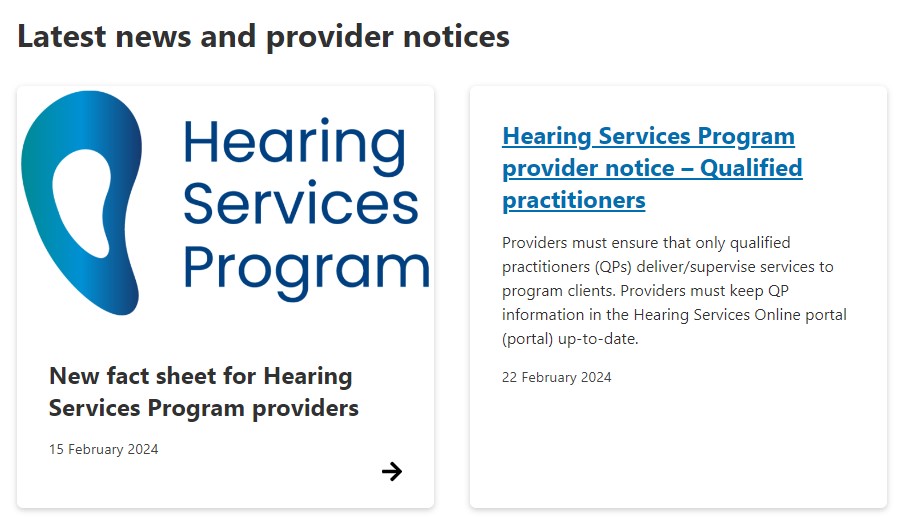Our understanding of complex content allows the Biotext team to develop strategies and content that fully meets user and business needs.
We develop content strategies to meet the long-term communication needs of our clients. A content strategy considers both business goals and user needs, and lays out everything clients need to develop and maintain effective content. We also develop the tools – such as workflows, templates and style guides – to empower client teams and enable them to use the strategy to make projects easier.
Our role:
|
|
Along with our work on a health communications strategy for CALD communities, our partnerships and projects include:
Hearing Services Program, Hearing Services Office
Recognising that their current website was outdated and difficult to navigate, in 2020 the Hearing Services Office (HSO) at the Department of Health was looking to improve the website and processes for publishing content. Biotext developed a content strategy and design for the Hearing Services program website, which included user research in the form of interviews with stakeholders (internal and external), a website survey and analytics. Using this information, Biotext conducted a card sorting exercise to inform the new information architecture and validated it with tree testing. Finally, Biotext conducted usability testing using wireframes of the new Hearing Services Program as well as of the health.gov.au platform more generally.
Biotext made recommendations to improve the new website and internal processes. We also delivered a content audit and plan, a writing guide and many other resources that the HSO can draw on to guide the development of their future website.

NSW Climate Data Portal, NSW Department of Planning and Environment
The NSW Climate Data Portal is the source of authoritative climate data and projections for NSW to help make climate-informed decisions. We worked closely with the department to draft a content strategy to inform a redeveloped portal that caters to a range of users. Key parts of the strategy include:
- proposed user groups and target audiences based on existing user research and insights from the department – this included creating journey maps and job stories for target user groups to inform content recommendations
- an audit of content on the current portal website
- a map of the current content ecosystem, including key entry points for different user groups
- proposed information architecture, validated through testing with current and future portal users
- a writing guide to help NSW DPE staff create effective, best‑practice content for the portal to meet the needs of portal users.
Person-centred care webpages, Australian Commission on Safety and Quality in Health Care
Person-centred care is widely recognised as a foundation to safe, high-quality health care. The person-centred approach treats each person respectfully as an individual human being, and not just as a condition to be treated. There is good evidence that person-centred care can lead to improvements in safety, quality and cost-effectiveness of health care, as well as improvements in patient and staff satisfaction. The Australian Commission on Safety and Quality in Health Care provides a wide range of resources and information are available to help healthcare organisations understand and implement best-practice person-centred care. They wanted to make it easier for users to find the information and work their way through the various aspects of implementing person-centred care. Biotext audited existing webpages and content on the Commission website, developed a new information architecture to improve navigation for a set of pages and subpages, and wrote new pages to guide users and provide useful content.
National Gene Technology Scheme, Department of Health
The National Gene Technology Scheme did not have a standalone website; it sat within the Department of Health’s ‘For professionals’ section, which was misleading as the scheme is more than just health. The departmental team wanted a standalone web presence that instilled trust in users. Biotext completed a content audit and analysis of the existing webpages. This was part of a bigger project in which user experience experts performed in-depth user testing and analyses with contributions from Biotext. Based on these data, Biotext drafted a new information architecture for the website, and made recommendations for gaps in content. The user experience experts created a new digital presence for the scheme, which they verified through usability testing. Biotext then created a comprehensive content map to map the old URLs to the new information architecture and suggested source documents for the new content, based on existing PDFs and the usability testing.